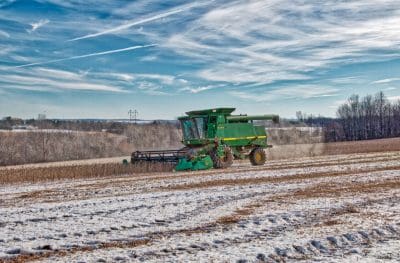
The US summer crop was very late last year due to a wet start, and some growers were harvesting soybeans in the snow. Photo: Farm Credit East
THE January World Agricultural Supply and Demand Estimates (WASDE) report tends to be significant, given it usually holds the final numbers in terms of yields, harvested area and production for the crop year in the United States.
However, the case is not closed on 2019 US production just yet as the United States Department of Agriculture (USDA) acknowledged it would resurvey producers in Michigan, Minnesota, North Dakota, South Dakota and Wisconsin for corn production, and Michigan, North Dakota and Wisconsin when it comes to soybean production.
Heading into last Friday’s report release, much of the market chatter suggested that the report would be bullish, based on the expectation of lower summer-crop yields.
The opposite happened, with the USDA raising the national yield for both corn and soybeans.
Increased corn demand
US corn production was forecast at 347.7 million tonnes (Mt) with an average national yield of 10.55 tonnes per hectare, slightly higher than last month’s yield estimate of 10.48t/ha.
Globally, corn production in South America was left unchanged by the USDA with Brazil and Argentina forecast to produce 101Mt and 50Mt respectively. These numbers seem to belie the dry conditions being experienced in many parts of Brazil and Argentina this summer.
The only production increase among the major exporters was Russia ,which the USDA increased by 500,000t to 14.5Mt. The wash-up of all the changes was an increase in global output by a little more than 2Mt to 850Mt excluding China, and 1111Mt including China.
The bullish part of the corn equation comes in the demand number, up by more than 6Mt globally compared with the December report’s figure. The US accounted for just under 6Mt, with a 1Mt increase in China countered by a 500,000t decrease in Ukraine, and several other minor downward revisions.
The USDA pegged final 2019 US soybean production 90.4Mt, on an average yield of 3.19t/ha compared with a 90.2Mt crop and an average yield of 3.15t/ha in the December report.
This was a surprise to most analysts, who expected to see the impact of the extremely challenging season continue to ripple through the country’s soybean supplies. Nonetheless, this is still 20 per cent lower than the previous season’s production of 112.5Mt.
Dry in South America
Like corn, the South American soybean production numbers remain steady, with Brazil estimated to produce 123Mt this summer, and Argentina expected to harvest 53MT.
Brazil’s agricultural statistics agency Conab released estimates last week that seem to ignore drought worries and support the USDA number. They are forecasting soybean production at 122.2Mt off 36.8Mha.
Eventually, soybean losses will happen if it remains dry, but most agronomists believe the current lack of moisture only affects the first corn crop at this point in the season.
The state raising the biggest concern is Rio Grande do Sul, the top summer-corn producer in the country. Conab maintained its estimate for first-crop corn production at 26.6Mt, 3.8pc below the 2019 crop, and based on a 1.1pc increase in the seeded area.
Australian wheat numbers high
Global wheat production for the 2019/20 marketing year was reduced by a meagre 1Mt to 764.4Mt. Half of that decrease was in Australia, where the USDA decreased production by 500,000t to 15.6Mt. While this is getting closer to reality, it is still at least 1Mt higher than most domestic estimates.
Argentine production remained at 19Mt against the latest Buenos Aires Grain Exchange (BAGE) estimate of 18.8Mt. BAGE increased their estimate by 300,000t last week on the back of better than expected yields in the late-harvested regions.
The balance of the global production decrease was in Europe with the Russian crop decreased by 1Mt to 73.5Mt and the European Union (EU) crop increased by 500,000t to 154Mt.
On the wheat-export front, global trade for the 2019/20 marketing year was increased by 1.3Mt to 181.1Mt.
The US, Argentine and Canadian numbers were all unchanged compared with the December report. The major tweaking was in Europe, where the Ukrainian and EU export numbers were increased by 500,000t and 2Mt respectively, and the Russian forecast was decreased by 1Mt on the back of lower supplies.
The USDA adjustment to the Australian wheat export number was hardly worth the token effort, with a mere 200,000t shaved off expectations.
Like the production forecast, the figure of 8.2Mt is at least 1Mt higher than most domestic expectations, and it simply should not be possible given domestic demand and low harvest receivals in Western Australia and South Australia.
Looking at US new-crop, the USDA reckons their farmers have planted 12.47Mha of winter wheat. This compares with 12.61Mha last year, and is the smallest winter wheat area since 1909.
World barley cut
Global barley production was decreased by 700,000t to 156Mt, up more than 12pc, or 17.4Mt compared with the 2018/19 season. Australia was down 200,000T to 8.2Mt, EU was up 500,000t to 62.75Mt and several minor producers collectively dropped by 1Mt.
The net change to global demand was minor at 100,000t, but the USDA did make some quite hefty regional adjustments to arrive at total demand of almost 153Mt. The big one was a 900,000t decrease in Chinese demand, potentially decreasing Australian exports over the coming months.
Countering that were demand increases of 400,000t in the EU and 600,000t in Turkey.
Most importantly, Saudi Arabian demand was untouched at 8.5Mt, a year-on-year increase of 20pc or 1.5Mt.
All this leaves 2019/20 global ending stocks at just under 21Mt, down 1Mt on last season’s number.
It could be said that last week’s WASDE report was mildly bullish for wheat, barley and corn, but on the whole, it was quite underwhelming for a report that invariably has huge trade and market ramifications.
This article was written by Grain Brokers Australia
Grain Central: Get our free daily cropping news straight to your inbox – Click here

HAVE YOUR SAY